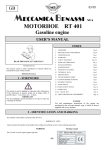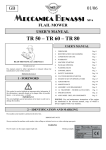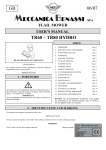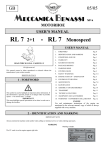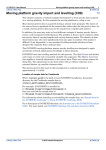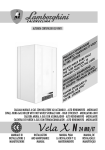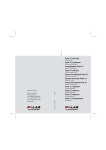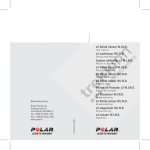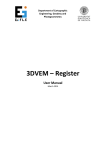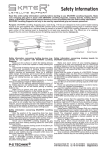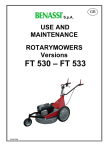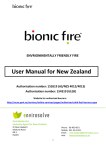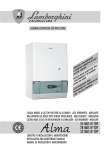Download user`s manual motormower f 213 user`s manual
Transcript
07/05 GB USER’S MANUAL MOTORMOWER F 213 USER’S MANUAL READ THIS MANUAL CAREFULLY All right reserved This manual cannot be either reproduced or released without the manufacturer’s prior written consent. PRINTED IN ITALY 1 - FOREWORD This symbol is used to highlight an important safety information. If this information is ignored, people are in danger either of possible injures – even serious ones – or death. 1. FOREWORD Pag. 0 2. IDENTIFICATION AND MARKING Pag. 0 3. CONDITIONS AND USE Pag. 1 4. WARRANTY Pag. 1 5. VIBRATIONS-NOISE-STABILITY Pag. 2 6. WARNING SIGNS Pag. 2 7. SAFETY WARNINGS Pag.3-4 8. TECHNICAL DATA Pag 5 9. DIMENSIONS – MEASUREMENTS Pag.5 10. DESCRIPTION OF CONTROLS Pag .6 11. MACHINE PREPARATION Pag. 7 12. STARTING OF THE MACHINE Pag. 8 13. WORK STARTING/STOPPING Pag. 8 14. MAINTENANCE - LUBRICATION Pag. 9 15. TROUBLES AND SOLUTIONS Pag. 9 16. RULES FOR A GOOD WORK Pag.10 17. DECLARATION OF CONFORMITY Pag.10 IMPORTANT This term highlights special precautions to be taken in order not to damage the machine. ENGINE :Use and maintenance instructions of the engine are mentioned in the relevant manual, copy of which is always supplied with every machine. 2 – IDENTIFICATION AND MARKING The machine serial number is printed on the drive box. IMPORTANT NOTE Always mention the machine serial number when calling our technical service or when ordering spare parts. MARKING The CE mark is on the engine support right side. Marking example. 3 - CONDITIONS AND USE 4 - WARRANTY This manual gives you general information on how this machine should be used and maintained. For any technical problem , please, call Your confidential dealer. If in doubt on causes and possible solutions for a certain trouble, please, call our authorized dealer. This should be absolutely done during the warranty period, since any repair made by non-authorized workshops makes this warranty null and void. Bear always in mind that the authorized dealer has all special tools, technical specifications and spare parts necessary for properly fixing the machine. Therefore, he should be called in case of any doubt on maintenance specifications and/or procedures. Some pages of this manual might not be perfectly right due to misprints or production changes. For this reason, call Your dealer before being perfectly familiar with this machine and personally maintaining this machine. For further information on use and maintenance of this machine, ask your authorized dealer for the proper technical manuals. Our materials have a 12 months warranty (coverings and electrical parts are not included). The manufacturer agrees on replacing those parts considered as faulty free of charge. Purchaser will be charged with labour costs – necessary for repairing the machine – and possible transport costs. Both the warranty claim and the returned piece should always be addressed to our Spare Parts Department and accompanied by regular freight bill mentioning all the machine details. As far as materials available on the market – especially engines – are concerned, regulations of our supplier will apply and applications for possible technical service should be addressed to the local specialized technical service centres. • This machine has been designed to be used in compliance with what specified in the machine descriptions and safety warnings of this instructions manual. • Any other use is not allowed. The manufacturer is not responsible for damages caused by any use then the intended use. The user is fully responsible for any possible risk. • Use, maintenance and repair clauses prescribed by the manufacturer are also integral part of the machine intended use. • Only people familiar with this machine and well aware of its hidden risks can use, repair and maintain it. • The manufacturer is not responsible for damages caused by non-authorized changes made on this machine. • Besides warnings mentioned in this manual, please, also comply with general regulations on safety and accident prevention of EEC and the country in which this machine will be operating. Descriptions, figures and technical features mentioned herein are non-binding for the Manufacturer. These are mentioned as mere information. The Manufacturer reserves the right to make any change at any time without being bound to update this publication. Copyright of MECCANICA BENASSI S.P.A.” -1- 5 – VIBRATIONS – NOISE - STABILITY IN CASE OF CONTINUOUS USE OF THE MACHINE IT IS RECOMMENDED THAT PROTECTIVE HEARING EQUIPMENT IS USED. VIBRATIONS The vibrations of the machine have been taken according to the bill EN 709 and EN 1033 The values obtained in m/sec. are the followings: Vibrations on the vertical line 3,36 m/sec Vibrations on the transverse line 1,71 m/sec Vibrations on the running line 2,02 m/sec NOISE The noise of the machine has been measured according to the rules pr EN 709 and pr EN 1553 The following data has been noticed IN dB (A) Maximum equivalent level of acoustic pressure to the right ear of operator : With 3600 r.p.m. engine 86 dB(A) With 3060 r.p.m. engine (85% of the power) 83,1 dB(A) STABILITY OVERTURN ANGLE measured in static conditions in laboratory on inclined plane Tip angle towards right 39° Tip angle towards left 38° 6 - WARNING SIGNS “DANGER” FIRE RISK “SAFETY WARNINGS” “DANGER” BLADES AND CUTTING PARTS IN WORK. KEEP HANDS AND FEET FAR “READ USE INSTRUCTIONS “ “DANGER” KEEP CHILDREN FAR FROM THE MACHINE “DANGER” BURNING RISKS -2- 7- SAFETY WARNINGS Before the machine is operating, read the Use and Maintenance manual thoroughly, so that you are fully aware of all the operating controls and safety aspects of the machine. Before starting the engine , be sure that the SAFETY DEVICES are well working and fitting. Without these cares the operator might work in a danger situation. DON’T SABOTAGE THE ENGINE STOP’ SAFETY DEVICE AND THE DISENGAGEMENT DEVICE. THE MACHINE MIGHT BECOME EXTREMELY DANGEROUS! 1) This machine has been designed and manufactured for being used by one operator only, and is driven by means of the appropriate handlebars. Any other use is not permitted.! 2) Before operating the machine, read the Use and Maintenance manual thoroughly, so that you are fully aware of all the operating controls and safety aspects of the machine. 3) Do not under any circumstances transport people or objects on the machine. 4) Always ensure that the machine’s safety devices are correctly mounted and in perfect working condition.. 5) Before use, check that all the controls, in particular the clutch, the Motor stop and the brakes (if fitted9are in good working order. 6) Any modification or spurious parts being fitted without the Manufacturer consent will nullify the guarantee, and any possible resulting damage will not answered for. 7) This machine must not be used by children or inexperienced persons. 8) Before operating the machine, check that the area is clear and free of debris and that there are no people within the working area (danger zone). The operator, will be held responsible for the safety of third parties, if these are found within the working area of the machine. Do not use the machine under these conditions. 9) Keep clear of cutting blades at all times while the machine is in operation. Pay particular attention when reversing; keep hands and feet clear. 10) Use the machine only with the handles in the correct working position. This allows a safe working distance between the operator and operating area. 11) Use only original accessories and spare parts to guarantee safety and correct operation of the machine. 12) Stop engine before refuelling and remove ignition key (if fitted). 13) Handle the fuel with care to avoid spilling on the machine; clean any spillage immediately. 14) Never refuel in confined places, in vicinity of open flames or near the source of sparks. No smoking! 15) Before starting the engine, check that all the controls are in the idle position. 16) Do not smoke when starting the engine! -3- 17) Do not run the machine in a confined area as toxic exhaust gas can kill. 18) Plan your work before commencing. 19) Do not use the machine when you are tired. 20) Engage the clutch gradually; sudden engagement could cause the machine to rear up. 21) The area next to the engine exhaust will most likely reach temperatures above 80°. Attention! Danger of scalding. 22) Always wear close fitting clothes and anti-slip shoes or boots. For safety reasons avoid using loose clothing. 23) Make regular checks that all bolts and nuts are well tightened. 24) Keep the area of work clear and clean. 25) Only use the machine in clear visibility. 26) Avoid working with blunt cutting blades. 27) Pay maximum attention and use good sense when operating the machine. 28) If you hit any objects during work, stop the machine and check for any damage immediately. 29) During movement to and from the area of work, disengage the Power Take Off. (P.T.O). 30) Pay attention when reversing the machine not to trip over anything. If you loose your balancer, release the handlebars immediately; the Motor stop or the disengagement will immediately stop the machine. 31) Do not under any circumstance attempt to by-pass the motor-stop device or remove the disengagement device. The machine would result having no safety precautions and would be extremely dangerous. 32)Do not travel down hill with the clutch disengaged or the gears in idle. 33) The machine’s speed must always suit the conditions and the environment. 34) Do not perform cleaning or maintenance operations of the machine when the engine is running. 35) Avoid sharps turns when travelling up hill, down hill or across steep slopes. 36) In steep descents, do not disengage the drive and do not change gear. 37) When possible, avoid working up or down hill .Always travel across the slope. 38) Do not work on very steep slopes (max.30%). 39)Avoid overfilling the fuel tank. 40) If there is fuel in the tank, avoid tilting the machine during maintenance or adjustment. 41) During use, keep the hot sections of the engine (i.e. cylinder head, exhaust, etc.) clean to avoid a build up of debris that will overheat the engine. 42) Whenever possible, stop the machine on level ground. 43) When stopping on unlevelled ground, engage 1stgear (up hill) or reverse gear (down hill). 44) If leaving the machine for a long time, ensure it is inaccessible to children and inexperienced people. Close the fuel tap (if fitted). 45) Do not leave the machine with the engine running. 46) The maintenance instructions of the machine must always be carefully followed and worn parts replaced when necessary. 47) If the machine is to remain unused for some time, clean it accurately and insert the appropriate protections. 48) Apart from the previous items, it is necessary to take heed of the specific safety norms in force in the Country where the machine is operating. -4- 8 – TECHNICAL DATA ENGINE 4 STROKE on the belt with idler CLUTCH single speed with wheels disengagement GEAR BOX 1090 r.p.m with left (Sx) rotation P.T.O height adjustable on revolving vibrations dampers HANDLEBARS 3.50.06 tyres WHEELS WEIGHT ACCESSORIES Complete machine about kg.56 ESM cutter bar 81 cm with eccentric movement 9 – DIMENSIONS AND MEASUREMENTS 81 -5- 10 – DESCRIPTION OF THE CONTROLS 1 WHEEL DISENGAGE LEVER Located on the right handlebar; it is necessary to disengage the wheels from the transmission. In “off” position ( RAISED LEVER the wheels are engaged when the lever is depressed the wheels are disengaged. This makes it possible to manoeuvre the machine both with engine running and shut down, it lets discharge the cutter bar when the engine is running but not working and it lets to move back the machine This control should never be used as a clutch. Pic. 1 2 GAS THROTTLE On the right of the handlebars, this permits the increase or decrease of the rpm of the engine ( power). By pushing the throttle forward you will increase the rpm and by pulling the throttle towards the operator the rpm will be reduced. 3 GUIDE PULLEY CONTROL Placed on the left of the handlebars it cuts off the engine from the transmission; in “off” position ( RAISED LEVER) all the transmission parts are disengaged ( neutral point), by lowering the lever on the knob you will give movement to all the parts of the transmission. 4 P.T.O ROD. It is necessary to insert the pto to the cutter bar .or rotary tiller You will disengage the pto by pushing the rod forward. To engage the pto the rod should be pulled towards the operator. The pto rod must always be operated when the transmission is disengaged. 5 HAND-LEVER FOR HANDLEBARS BLOCKING. It is necessary to fix the handlebars in the desired position. The handlebar can be regulated in 3 positions by means of a steel pin; when you have found the most suitable position for working, re-tighten the hand-lever,. Once the hand-lever is well tightened it can be put in the most suitable position by pulling it ( idle position) and pushing down the central knob : When you have found the desired position release the hand-lever and it will lock automatically 6 Rope knob for starting placed on the front of the engine 7 Engine drain oil cap it is necessary to drain the oil from the engine 8 Oil cap checking placed on the right of the engine lets check through the suitable bar the oil level in the engine 9 Cotter pin it is necessary to lock the wheels to the engine shaft. 10 Fixing pin for quick connection of the accessories to the machine 11 Shoes for cutter bar; are necessary to make the cut distance from the ground. -6- THE 2 LEVERS PLACED ON THE HANDLEBARS (HANDLEBAR POS. 1 AND POS. 3 ) AND PTO ROD( POS. 4) USED IN THE DIFFERENT POSITIONS LET : • • • • displace the machine in quiet both with engine in motion or stop operate the cutter bar with idle wheels displace the machine with stop engine, cutter bar or rotary tiller but with engaged wheels displace the machine by pushing, with disengaged wheels, both in front and rear with engine in motion and cutter bar engaged or disengaged 11 – MACHINE PREPARATION The machine is delivered packed in a cardboard box with the cutter bar and rotary tiller packed separately, due to their dimensions In the front rotary tiller is included the foot, while the tools support where the foot must be inserted is supplied separately, ( if You buy the rotary tiller after, You may already have the tools support). .) To assemble the machine proceed as follows: - take the machine out of the box (better with another person), lower the handlebars in the desired position and fix it with the hand-lever for handlebar locking. Once you have tightened the throttle its lever can be placed as you prefer by pulling upwards, pushing with Your thumb the screw on the head of the throttle itself; FOR MOTORMOWER VERSION - assemble the cutter bar to the movement with eccentric by means of 4 screws given with the machine. - oil or grease the coupling sleeve (male) of the cutter bar to the machine - take off the fixing pin from the mouth (female) of the machine - insert the coupling sleeve of the cutter bar to the machine, (this will be easier with the help of another person), ensuring that the axle of the pto shaft of the machine is at the same angle as that of the bar movement’s shaft. Once it is fitted right to the end of the coupling sleeve, insert the pin and fix it in the lower part with its split pin During this operation always keep the blade covered by its protection. Never force the joining as this could damage the centring. ATTENTION The machine is supplied with tired wheels. Tyres and wheels. These must be assembled in the correct position as shown in the picture Pic. 2 -7- 12 – STARTING OF THE MACHINE Before using the machine make sure you have understood all the instructions contained in this manual. Before starting the machine always check: - the oil levels in the engine and reducer case with proper dip-stick; - the air filter is well clean both inside and outside: brushwood and leaves near the filter could burn if they enter into contact with the superheated head of the cylinder - the tyres are at the right pressure ( 1.3 Bar) and correctly turned (see picture 6) - that all screws and nuts are well tightened - that all levers are in neutral position ( idle point) - that the guide pulley lever has a little play - that some motor fuel is in the carburettor and that the hole on the plug is open; refuelling must be carried out when the engine is stop by using the funnel provided together with a very thick net to avoid the introduction of impurities. Before starting the engine make sure there are no walls or obstacles either in front or behind you. To start the machine proceed as follows: - leave the guide pulley lever in normal position ( up ). Close the air to the carburettor ( starter), open the petrol tap, place the gas throttle at half gas and sharply pull the small rope of the recoil starter. When the engine is in motion cut out the starter. Let the machine warm up for some minutes before commencing operation. When the engine is new carry out a running-in period 13 – WORK STARTING and STOPPING Carefully inspect the field/garden you are working on and remove any foreign objects ( iron wires, stones, glasses, sticks etc.) that will affect the operation of the machine by causing damage to the machine. Insert the pto fully by pulling in the direction of the operator the proper lever. Gently accelerate the engine and gradually lower the guide pulley lever. The lever for wheels disengagement must be in neutral position ( lifted up), engaged wheels in motor mower version and disengaged wheels(idle) in walking tractor version ( with rotary tiller) Once the work is completed, to stop the engine, leave the guide pulley lever in neutral position ( lifted up ), fully pull the gas throttle lever backwards ( stop engine ) close the fuel tap. To move the machine when the engine is not in motion, disengage the wheels by lowering the lever for wheels disengagement. This lever must never be forced, if it will not disengage immediately push a little on the lever itself and at the same time move the machine forward and back the until the wheels are disengaged. -8- 14 – MAINTENANCE and LUBRICATION To optimise the efficiency of the machine it is necessary to maintain the machine correctly and to ensure the engine is fully lubricated. The machine is normally supplied packed without oil in the engine, as clearly indicated on the label attached to the engine. ENGINE. For suggestions, utilisation and maintenance of the engine strictly follow the instructions indicated in the proper book “ ENGINE UTILIZATION AND MAINTENANCE”. It is necessary to check the oil level every 5 working hours and replace it every 50 hours. Use SAE 40 oil in summer and SAE 20 oil in winter. The first oil change must be done after 10 working hours. Check the air filter is clean, especially if the machine is to work in barren or dusty conditions. GEAR REDUCTION. Check the oil level every 50 working hours by taking off the plug on the gear box case and keeping the machine in a horizontal position. If necessary, add oil SAE 80-90. It’s advisable to change the oil at least once a year. CUTTER BAR. Before starting work, check all the screws are well tightened . Every 4 working hours grease the internal blade support. Every 10 working hours grease the bush of the eccentric gear. Every 20 working hours grease the connection between the cutter bar and the machine. ROTARY TILLER Check all the screws of the blades are well tightened, change the oil in the rotary tiller body minimum once a year. Capacity oil cl 250. Before leaving the machine idle for a long time, it is necessary: - to wash it outside, to replace the oil in the engine and gear box, - to empty and to clean the fuel tank and to clean or replace the air filter, - to oil and to grease all the joints and mechanisms, - to replace or to repair the damaged parts, - to lubricate the cylinder with engine oil through the spark plug hole by letting the piston run several times, by pulling the rope of the starter, - place the machine in a sheltered place and with the wheels on wooden tables or, even better, keeping them away from the floor. 15 – TROUBLES and SOLUTIONS Few problems can occur that cannot be solved directly by the operator. ENGINE - The engine does not start; check that: - the petrol tap is open - if the engine is cold the starter is pulled - the petrol is reaching the carburettor - that the breather hole on the fuel tank is not obstructed - the carburettor jets are open, if not clean them with an air jet - there is a spark at the spark plug, to check this, unscrew the spark plug; connect it again to the wire, lean the metal part of the spark plug against the engine cylinder and make the pulley turn as for starting. If between the electrodes you do not see any sparks, check the cable joints, if there is not a problem there then replace the spark plug with another one of the same type. If this still does not solve the problem then there is probably a fault in the electrical installation ( sparking plug points, condenser, coil, etc.) In this case it is advisable to contact your nearest service assistant. -9- 16 – RULES FOR A GOOD WORK The engine should be put through a ‘running in’ period ( for at least 10 hours do not use more of the 70% of the available power of the engine) - always use the clutch before operating any levers or rods - do not over use the clutch disengagement. - never press the guide pulley levers, wheel disengagement or the PTO rod. If they will not engage move the machine with engaged wheels or with the guide pulley levers lowered by using a little pressure on the lever or rod that is hard to engage. - keep the handlebar joint cleaned and oiled - never over work the engine; if smoke appears from the exhaust pipe, this means that the engine is being put under stress - never work for long periods at maximum power, especially in hot periods - periodically check the pressure of the tyres (1.3 Bar) - when mounting the cutter bar, pay particular attention not to damage the centring and the grooves of the shafts, check the screws and the blocking pins are well tightened especially the screws that fix the cutter bar - never leave the machine out in the rain. 17 – DECLARATION OF CONFORMITY - GB - CE – DECLARATION OF CONFORMITY In compliance with CEE 89/392 regulations and subsequent changes MECCANICA BENASSI S.p.A , I-44040 DOSSO (FE) via Statale, 325 DECLARES, under is own responsibility, that the item called MOTORMOWER Model: F 213 From series-no.: 0000000001 * The number is printed on the machine’s gearbox . is manufactured by the above company in compliance with basic safety and health safeguard requirements specified in the regulation CEE 89/392 and subsequent changes. For checking the conformity with the above regulations, have been examined the following CEN rules: CEN UNI EN 709:98/A1 :2000. Dosso, (Italy) , the 13th July, 2005 MECCANICA BENASSI SPA L’Amministratore Unico - 10-











